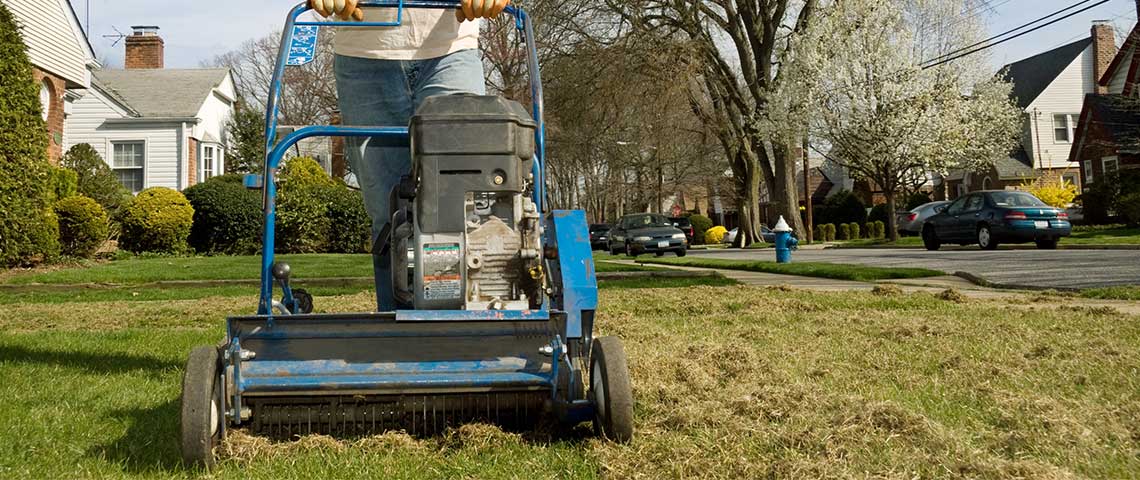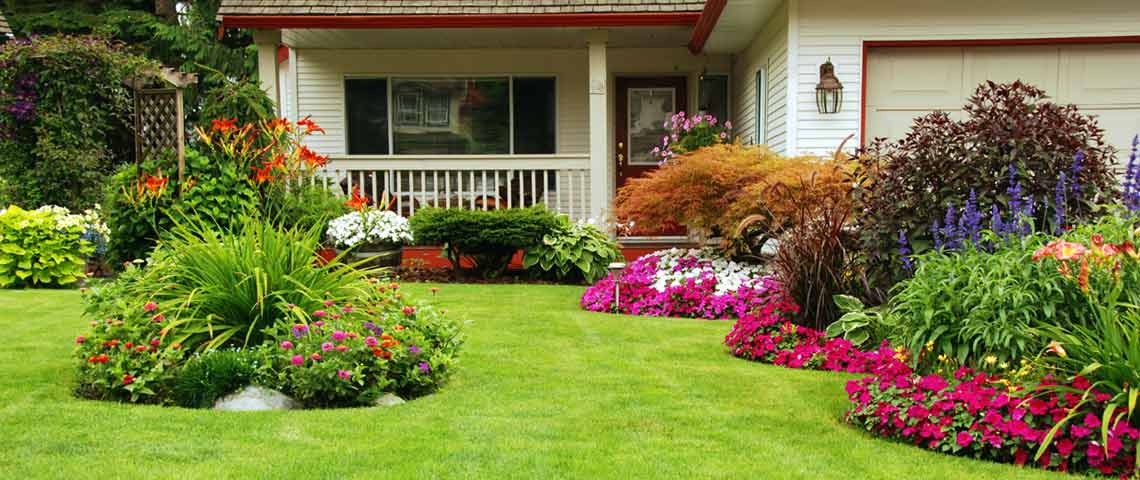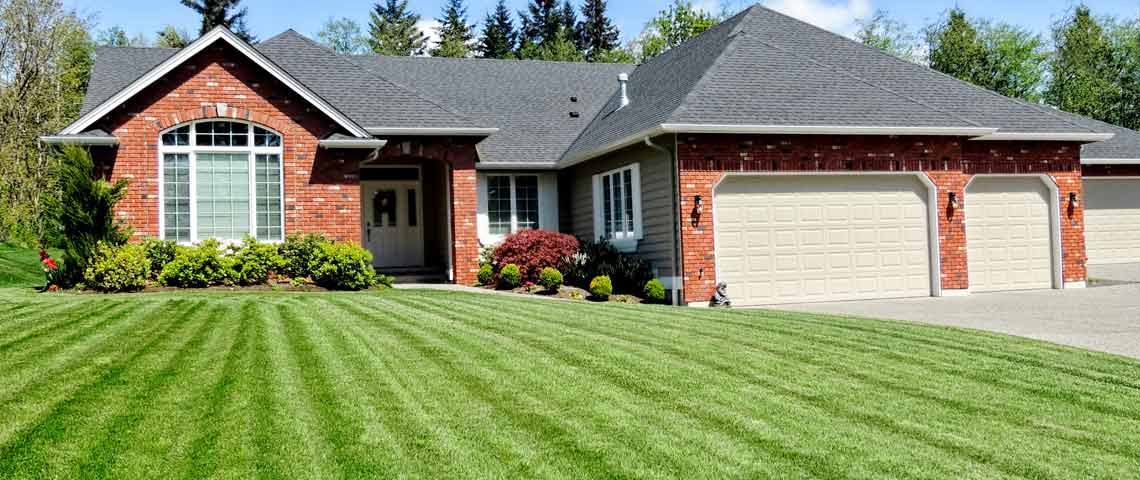Why, When and How to Dethatch Your Lawn
Not all lawns need dethatching, but when your lawn does need it, knowing how to dethatch your lawn is crucial to its future. Done properly, dethatching helps restore your lawn to health and keep it beautiful in years to come. By learning why, when and how to dethatch, you can keep your thick, lush grass on track. These lawn dethatching basics can help understand:
What is Thatch?
If you've ever seen a cross-section of soil and grass roots, you've seen the layer of organic debris known as thatch. A mix of dead and living plant material, thatch forms at the base of grass plants, where stems meet roots and soil. Some organic matter, such as small grass clippings or mulched leaves, break down quickly in healthy lawns, but other materials take much longer to decompose. When buildup outpaces breakdown, your lawn's thatch layer grows thicker.
A thin thatch layer, less than 1/2-inch thick, is beneficial to lawn health.1 It acts as an organic mulch to help conserve soil moisture and protect against big fluctuations in soil temperatures. A thin thatch layer allows water, nutrients and air to penetrate into soil and reach waiting plant roots. But when thatch grows thick, grass suffers.
Thatch layers of 1 inch or more become barriers instead of benefits. Thick thatch blocks water and fertilizer, and grass roots get trapped in thatch, where they're vulnerable to heat, drought and stress. Water from irrigation can accumulate in the thatch layer, too, so grass roots suffocate from lack of air. Thick thatch also provides a breeding ground for lawn disease and insect pests.
Some lawn grasses are more prone to thatch buildup than other. Vigorous, spreading grasses such as Kentucky bluegrass, Bermudagrass and creeping fescues, may need regular dethatching. Clump-forming grasses, such as tall fescue or perennial ryegrass, seldom have thatch problems. Lawns with overly low soil pH or compacted soil are also prone to thatch. Overfertilization and heavy pesticide use contribute, too.

When to Dethatch Your Lawn
Always check your lawn's thatch layer before dethatching. Take a garden trowel or spade and dig up a small wedge of your lawn grass and soil. You'll be able to see and measure its thatch layer. If your thatch is 1–2 inches or more, you've probably already seen signs of poor grass color and weak, thin growth. Once you've confirmed your thatch exceeds the healthy mark, the time for dethatching has come.
Like most major lawn projects, such as planting new lawns or overseeding existing lawns, dethatching should coincide with peak growth times for your grass type. Active grass growth helps speed your lawn's recovery.
Dethatch cool-season grasses, such as Kentucky bluegrass, in late summer or early fall. Dethatch warm-season grasses, such as Bermudagrass or Zoysia grass, after spring green-up, as they enter early summer's peak growth. Never dethatch when your lawn is dormant or stressed; you can damage it beyond recovery.
Lawn aeration and dethatching are two different processes, but they can work together to help your lawn. Aeration removes cores of soil, including their thatch layer, and creates paths for water and nutrient to penetrate thatch and compacted soil. This helps prepare thatch for removal and speeds the breakdown of existing thatch. Dethatching helps slice through thatch into soil and remove the barrier of thick, accumulated organic matter.
How to Dethatch Your Lawn
If your thatch is over 2 inches thick, you may want to consider hiring a professional for the job. Excessive thatch can take more than one removal session, and removing too much at once can damage grass roots. Your local county extension agent can help you decide which route to take. If DIY is more your style, you can dethatch your lawn in three ways:
- Manual dethatching rakes are heavy, short-tined rakes with curved blades designed to dig into your lawn and pull up thatch as you rake. Dethatching rakes are good for light thatch and general thatch maintenance on small lawn areas.
- Power rakes are mower-like devices with rotating, rake-like tines that dig into thatch at the soil level and pull it up. Power rakes work well for lawns with thinner thatch layers and grass that can withstand intense raking.
- Vertical mowers, also called verticutters, have vertical blades that slice down through the thatch layer and into soil, pulling thatch—and often grass roots—to the surface as they go. Verticutters are best for thick thatch layers on lawns in need of renovation. Blades adjust to control how much thatch you remove at once.
Most lawn and garden stores carry manual dethatching rakes. Equipment rental stores often keep power rakes and vertical mowers on hand, especial during dethatching season. Whatever option you choose, finish the job by raking up all the thatch debris and watering your dethatched lawn thoroughly.

What to Do After Dethatching
With dethatching done, it's an ideal time to overseed your lawn and get it back on track for thick, lush, green beauty. By choosing premium grass seed such as water-conserving Pennington Smart Seed, you improve your lawn's sustainability as you overcome thatch. For a quick, easy fix to thin grass, turn to Pennington Lawn Booster; this 3-in-1 product combines Smart Seed, professional-grade fertilizer and soil enhancers, all in a single, easy-to-use package.
To prevent future thatch problems, test your lawn soil every 3–4 years and follow soil test recommendations to keep soil pH and nutrients at optimal levels for thick, healthy grass growth. Your lawn may need lime to restore soil pH balance, which also promotes beneficial activity of thatch-reducing microorganisms.
Aerate heavy or compacted lawns annually and amend with gypsum to help loosen soil and encourage root growth. Fertilize your lawn, according to soil test recommendations, with the best lawn fertilizers to ensure it gets nitrogen it needs without over-fertilizing, and follow best practices for mowing and wise watering.
By learning why, when and how to dethatch your lawn properly and taking steps to prevent thatch, you can keep your lawn on track for healthy, thick, lush growth. Pennington is committed to providing you with the finest in grass seed and lawn care products so you can enjoy a beautiful, healthy lawn you're proud to own.
Pennington with design and Smart Seed are trademarks of Pennington Seed, Inc.
Sources:
1. P. Landschoot, "Managing Thatch in Lawns," Pennsylvania State University Center for Turfgrass Science.




